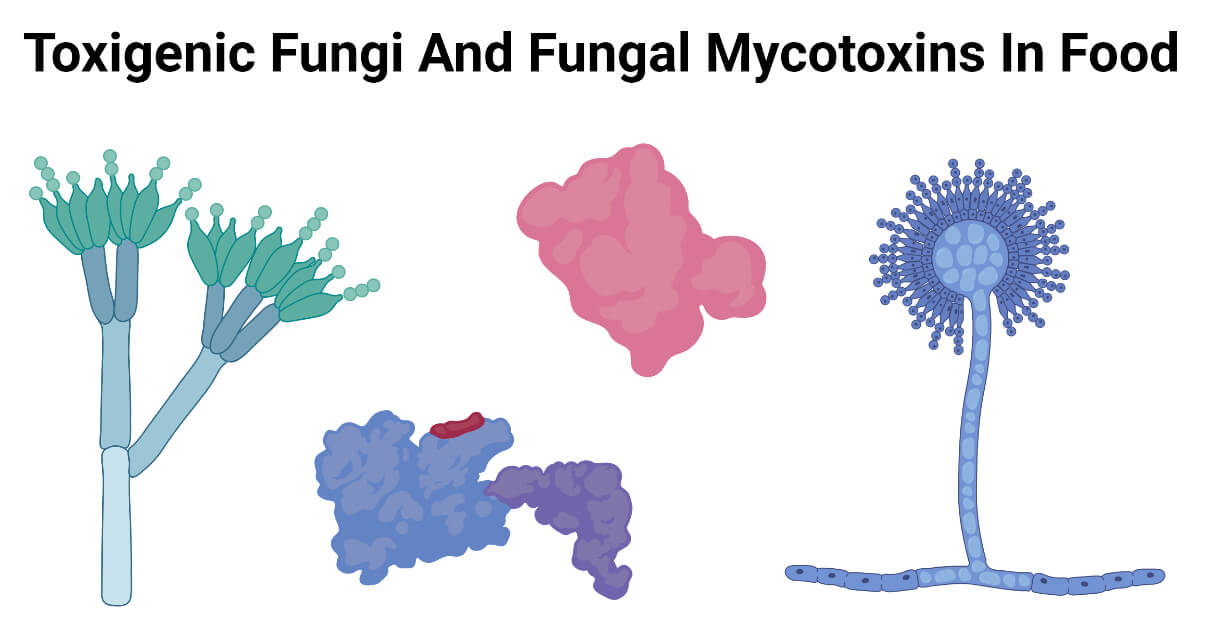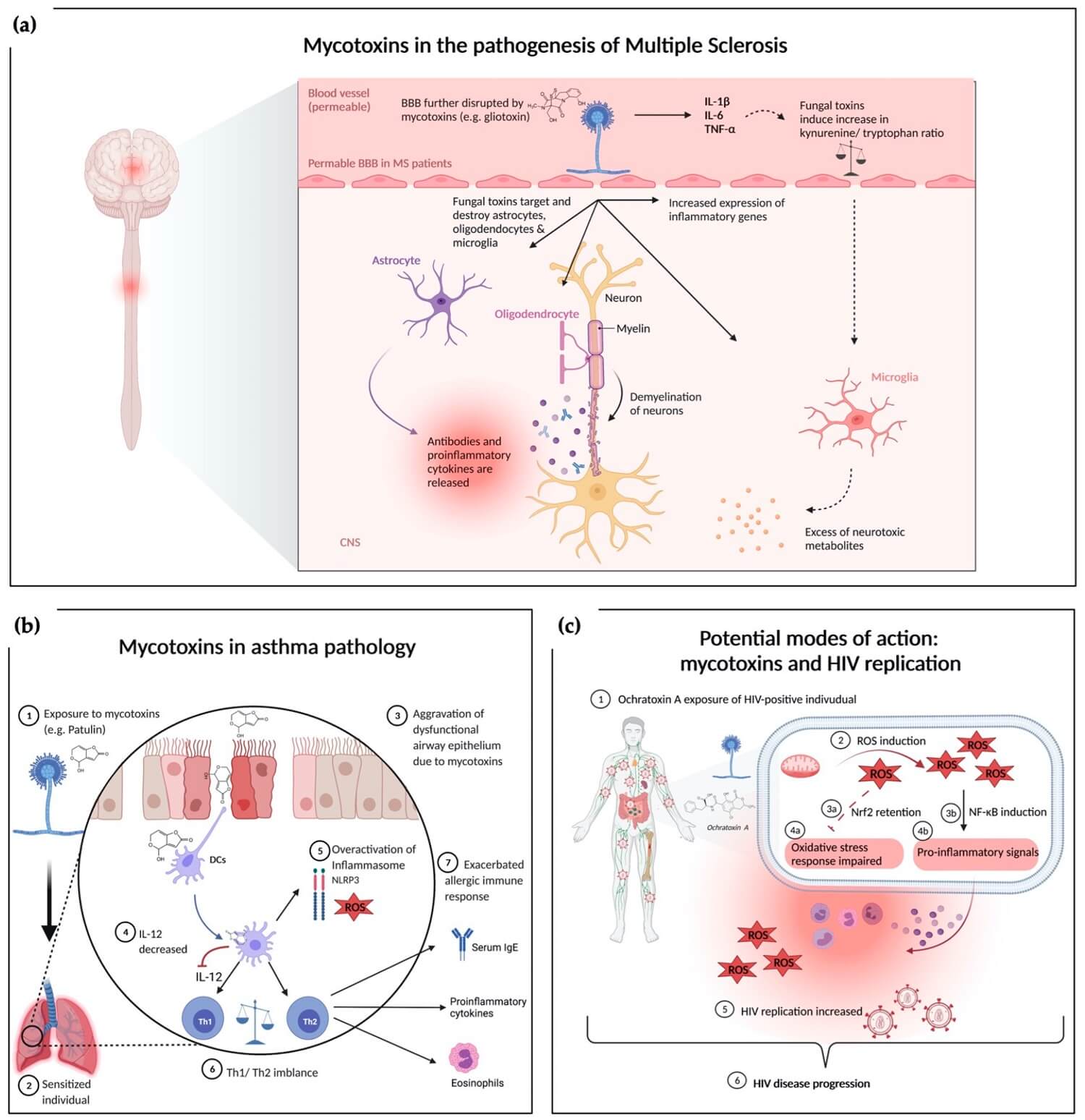Fungi are the most widely distributed free-living organisms on Earth with about 1,44,000 known species to date and many other unknown species are yet to be identified. Some of the common fungi that cause plant disease include yeasts, molds, rusts, smuts, mildews, slime molds, water molds, mushrooms, scabs, or cankers. They grow on soil and decompose dead plant matter and cause fungal diseases which causes a huge loss for the farmers.
Only a small number of fungi are associated with animal and human diseases like skin diseases, athlete’s foot, ringworm, candidiasis, fungal eye infection, and thrush.
Fungi are of three major groups: Multicellular filamentous molds, Macroscopic filamentous fungi, and single-celled microscopic yeasts. Multicellular filamentous molds are made up of multiple hyphae and create long branching chains called a mycelium where digestive enzymes are secreted at the hyphal tip. These digestive enzymes decompose the organic matter and use smaller molecules as a portion of food for their growth.

Hyphae contain spores on their aerial branches which protect them from harsh environmental conditions. Macroscopic filamentous fungi are similar to molds but they produce visible fruiting bodies with the spores in them like mushrooms and toadstools.
Microscopic yeasts play an important role in both production and infection in humans. Saccharomyces species are mostly used in baking and brewing industries while Candida species are infection-causing pathogens.
Interesting Science Videos
Fungal Mycotoxins
- Under high temperature and humid conditions, filamentous fungi grow on food during long-term storage and transportation producing mycotoxins.
- Mycotoxins are secondary metabolites produced at the end of the exponential growth phase by using specialized pathways with the use of their specific genes.
- Mycotoxins are low molecular weight compounds and are toxic to humans and animals causing food poisoning illnesses, teratogenic effects, cancers, kidney, and liver damage.
- Aspergillus and Penicillium species such as A. flavus, A. ochraceus, A. parasiticus, A. niger, A. nomius, P. verrucosum, P. nordicum, P. dipodomyis and P. chrysogenum grow and invade crops after harvest and produce toxins during storage.
- Fusarium and Claviceps species such as F. cerealis, F. oxysporum, F. proliferatum, F. verticilloides, F. sporotrichioides, F. moniliforme, F. graminearum, and Claviceps purpurea infect crop before harvest.
- Other mycotoxin-producing member includes Alternaria, Trichothecium, Cladosporium, Byssochlamys, and Sclerotinia.
- These toxin-producing organisms are influenced by various extrinsic conditions such as moisture, temperature, pH, and water activity.
- Most cereal and grain products such as corn, wheat, rice, sorghum, maize, soybean, some spices (chili peppers, black peppers, coriander), and nuts like pistachio, almond, walnut, peanut, and brazil nuts are susceptible to fungal infection.
- The presence of toxigenic growth of the mold in food products does not indicate the presence of mycotoxin while on the other hand mycotoxins may be present if the mold is not present since the toxins may remain long after the disappearance of mold.

(a) Mycotoxins in the pathogenesis of Multiple sclerosis: exposure to GTX alters the blood-brain barrier.
(b) Mycotoxins in asthmatic conditions: exposure to mycotoxins worsens the respiratory epithelium barrier impairment.
(c) Potential modes of action between mycotoxin exposure and HIV replication: exposure to mycotoxins modulates immune response via induction of ROS.
Image Source: Stephanie Kraft et al. 2021.
Fungal Mycotoxins Epidemiology (Mycotoxicoses)
- Many outbreaks have been reported in the recent year causing mycotoxicoses in humans as well as domestic animals.
- The main source of these outbreaks was the consumption of long-term stored molded food and feed that contained toxigenic mycotoxin.
- The first outbreak was reported in Europe during the Middle Ages where thousands of people were killed by this disease which was called St. Anthony’s fire at that time.
- Claviceps purpurea was recognized as the cause of the disease in the 19th century which parasitized rye and other plants.
- During World War II, a human disease was caused in Russia due to the consumption of long-term stored moldy grain which resulted in several dermal necroses, hemorrhages, leucopenia, and bone marrow degradation.
- In Japan, these toxins caused serious liver damage to the animals by the consumption of feed of yellowed rice which contained mold.
- From the sample of yellow rice, a number of Penicillium species were isolated such as P. citreo-viride, P. citrinum, P. islandicum and P. rugulosum.
- The presence of mycotoxin received attention when a large outbreak occurred in turkey poults in England where numbers of poultry animals, ducklings and other farm animals were heavily affected by the contaminated feed.
- The contaminated feed component contained peanut meal from where Aspergillus flavus was isolated and the toxic compound was named aflatoxin.
Clinical manifestations of Mycotoxins
- Mycotoxin causes four kinds of toxicity: acute, chronic, mutagenic and teratogenic.
- Acute toxicity poisoning is the most commonly occurring effect that damages the liver and kidney with the death of a patient in extreme cases.
- The common symptom of mycotoxicoses is food poisoning illnesses like vomiting, diarrhea, abdominal pain, fever, chronic fatigue, skin rashes, insomnia, depression, anxiety.
- Other chronic toxicity severe effects are carcinogenicity, skin necrosis, leucopenia, autoimmune diseases, neurological issues, chronic organ damages and static shocks.
Mycotoxins and Toxigenic fungi
Aflatoxins
- Aflatoxins are potent mycotoxins produced by Aspergillus species such as A. flavus, A. parasiticus, A. nomius, A. pseudotamarii and A. ochraceoroseus.
- Not all toxins produced by different strains are toxigenic, only 35% of A. flavus strains produce aflatoxin whereas the majority of strains of A. parasiticus are toxigenic to humans and animals.
- Aflatoxins are of four main types: B1, B2, G1 and G2.
- Aflatoxin B1 is the most toxic compound that causes adverse effects like liver cancer, reproductive problem, suppression of the immune system and death.
- Aflatoxin M1 is associated with nursing animals that may pass the toxin through milk to their babies.
- The maximum limit of Aflatoxin B1 and M1 in food, feed and milk should be less than 2µg/kg and 0.05µg/kg according to European Union.
Ochratoxin A
- Ochratoxin A (OTA) is a toxin produced by A. ochraceus, A. carbonarius and Penicillium verrucosum.
- OTA is mainly associated with barley, coffee, cocoa, vine fruits, spices and beverages.
- Ochratoxin A targets the kidney organ and forms a urinary tract tumor and is considered carcinogenic to humans.
- This toxin remains for a long time in the animal body even after slaughtering but it is reported to date that OTA is not produced in plants in the field.
Patulin
- Patulin is the smallest mycotoxin molecule produced by the molds such as Penicillium expansum, Aspergillus species and Byssochlamys.
- This smallest mycotoxin contaminates fruit and vegetable-based products, especially apples.
- Fresh apple juice is the major contaminating source of patulin in humans who consume it on a daily basis.
- Acute toxicity occurs when 9 to 55 mg/kg of patulin concentration is consumed which causes agitation, convulsions, dyspnoea, pulmonary congestion and ulceration.
Fumonisins
- Fusarium fungal pathogens such as F. verticillioides, F. proliferatum and Alternaria alternata f. sp. lycopersici produce fumonisin toxins.
- The major substrate of fumonisin is corn-based products and when consumed causes pulmonary edema, kidney and liver cancer.
- Fumonisin B1 is responsible for animal diseases such as encephalomalacia in horses and hepatocarcinoma in rats.
- F. verticillioides toxin is carcinogenic to humans and should to consumed under acceptable limits of 800 to 1000 µg/kg.
Deoxynivalenol
- Deoxynivalenol (DON) toxin is produced by Fusarium species such as F. graminearum. F. culmorum and F. pseudograminearum.
- These species contaminate corn, wheat, oats, barley, rice and other grains during storage and have been detected in buckwheat, flour, bread, breakfast cereals, noodles and infant foods.
- Deoxynivalenol toxin causes acute health effects such as nausea, vomiting, diarrhea, abdominal pain, throat irritation and fever.
- The maximum limit of DON toxin is 1.1 µg/kg according to Pieters et al. (2002).
Other mycotoxins
- Other mycotoxins involve trichothecenes by Fusarium species in substrates like barley, wheat and maize.
- Penicillium toxins such as citrinin and sterigmatocystin toxin by Aspergillus species do not cause any adverse effects and are less toxic to humans and animals.
Fungal Mycotoxins Detection and analysis
- Bioassay methods are the most dependable types for mycotoxin detection in animals, plants and microorganisms by using laboratory animals for cytological assays, skin tests.
- Culture methods like dilution plating and direct plating are the most appropriate method for mycotoxin detection from liquid and solid samples.
- Immunoassays are sensitive and specific for mycotoxin detection and are widely used.
- Molecular identification methods such as RT-PCR, Restriction fragment length polymorphism (RFLP), denaturing gradient gel electrophoresis (DGGE), PCR and single-strand conformational polymorphism (SSCP), loop-mediated isothermal amplification (LAMP) assay.
- Recent developed novel molecular technologies such as DNA microarray and DNA barcoding are used in medical applications.
Prevention and control measures of mycotoxin in food
- An integrated management program in the food chain must be followed to prevent mold contamination during the process.
- The program includes preventing insects to damage the crops in the field, reducing drought stress, and preventing the inoculum to build up during storage and transportation.
- Physically removal of dust and broken grains may reduce the mycotoxin-contaminated materials.
- Good Agricultural Practices (GAP) and Good Manufacturing Practices (GMP) must be followed to prevent mycotoxin formation.
- Patulin can be removed by chemical treatment such as activated charcoal and sulfur dioxide.
References
- Nigam, P. S., & Singh, A. (2014). METABOLIC PATHWAYS | Production of Secondary Metabolites – Fungi. Encyclopedia of Food Microbiology, 570–578.
- Laitila, A. (2015). Toxigenic fungi and mycotoxins in the barley-to-beer chain. Brewing Microbiology, 107–139.
- Moss, M. (2009). Toxigenic fungi. Foodborne Pathogens, 1042–1059.
- COLE, R. J., CUTLER, H. G., & DORNER, J. W. (1986). Biological Screening Methods for Mycotoxins and Toxigenic Fungi. Modern Methods in the Analysis and Structural Elucidation of Mycotoxins, 1–28.
- Munaut, F., Van Hove, F., & Moretti, A. (2011). Molecular identification of mycotoxigenic fungi in food and feed. Determining Mycotoxins and Mycotoxigenic Fungi in Food and Feed, 298–331.
- Hocking, A. . (2014). FUNGI | Foodborne Fungi. Encyclopedia of Food Microbiology, 68–75.
- BULLERMAN, L. B. (1979). Significance of Mycotoxins to Food Safety and Human Health. Journal of Food Protection, 42(1), 65–86.
- Pitt, J. I. (2000). Toxigenic fungi and mycotoxins. British Medical Bulletin, 56(1), 184–192.
- Tantaoui-Elaraki, A., Riba, A., Oueslati, S., & Zinedine, A. (2018). Toxigenic fungi and mycotoxin occurrence and prevention in food and feed in northern Africa – a review. World Mycotoxin Journal, 1–16.
- Kraft S, Buchenauer L, Polte T. Mold, Mycotoxins and a Dysregulated Immune System: A Combination of Concern? International Journal of Molecular Sciences. 2021; 22(22):12269. https://doi.org/10.3390/ijms222212269
